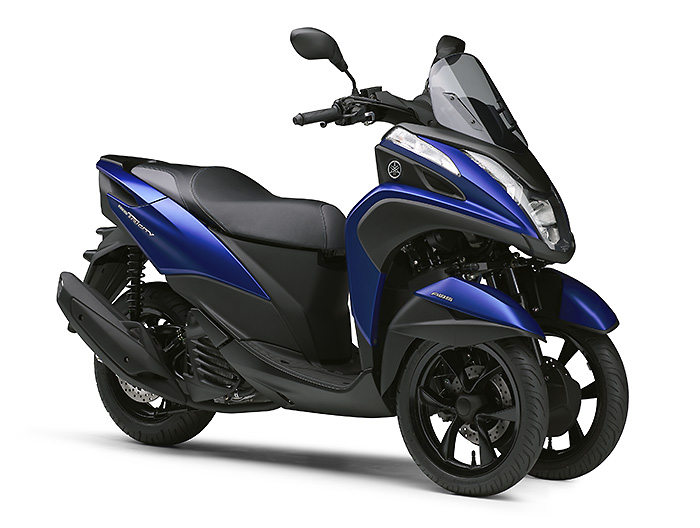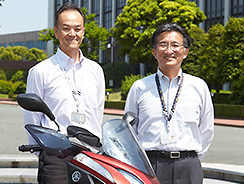The Near Future Created by LMW Vehicles
介绍雅马哈发动机技术背后的故事。
2014 年 Tricity 125 的发布让很多人第一次接触到雅马哈的 LMW *技术。然后,在次年的东京车展上,雅马哈展示了 MWT-9 原型车(#1)作为参考车辆,展示了采用该技术的新型运动移动方式。它是在“转弯大师”概念下构思的,旨在重新定义转弯在运动骑行领域的意义。然后在 2016 年 9 月,雅马哈发布了新的 Tricity 155 型号(#2),配备 155cc “BLUE CORE”发动机,实现真正的骑行乐趣和良好的燃油效率,以及新开发的车架等。 Tricity 155 在其他国家/地区的后续发布之前在欧洲推出,可以在高速公路上骑行,从而扩展了可供骑手使用的路线和使用选项。
*LMW(多轮倾斜):雅马哈的名称,表示具有三个或更多轮子的车辆,可以像摩托车一样倾斜转弯(日本专利局商标 #5646157)。
| 雅马哈 LMW 技术的历史 | |
|---|---|
| 1976 | 为使用两个前轮的车辆申请的各种专利 |
| 2007 | Tesseract四轮概念车亮相东京车展 |
| 2008 | 研发继续在 OR2T 原型上实现 Tesseract 概念 |
| 由于 2008 年全球金融危机,LMW 技术的研发暂停 | |
| 2010 | 为研究下一代移动性的可能性而启动的有限期项目 |
| 决定使用 LMW 技术将具有两个前轮的车辆商业化 | |
| 2011 | 全面启动开发 LMW 生产模型的项目 |
| 2014 | Tricity 125 将于 4 月在泰国和 9 月在日本开始销售 |
| 2015 | MWT-9 原型车作为参考车在东京车展上展出 |
| 日本市场发售的Tricity 125 ABS版 | |
| 2016 | Tricity 155 于 9 月作为全球车型发布,开始在欧洲销售 |


LMW Developer Interview: From Industrial Robots to LMW Vehicles
Interviewees (#3)
Takashi Kaieda
General Manager of LMW Development Division, PF Model Development Section, PF Model Unit, Yamaha Motor Co., Ltd.
Kazuhisa Takano
Group Leader of LMW Development Division, PF Model Development Section, PF Model Unit, Yamaha Motor Co., Ltd.
Takashi Kaieda was in charge of consolidating business strategy and served as the division’s general manager from the very beginning of Yamaha’s production LMW development. Looking back on the state of things when production model development began in 2011: “Because I had worked on developing industrial robots for more than 20 years after I first joined Yamaha, when I was put in charge of the LMW project it was honestly like changing jobs,” says Kaieda. “So it was basically starting out from scratch; I wasn’t able to use most of the know-how and connections I had acquired until then.”
From Building MotoGP Racebikes to Developing a Production Model for the First Time
“My dream of building the world’s fastest motorcycle was realized when I was put in charge of developing the chassis for our MotoGP factory racebike,” says Kazuhisa Takano. “After that I thought it might be time to move on to a new career step and it was just at that time that I got this offer.”
As the Project Leader for the Tricity 125, Takano would have to build Yamaha’s first bike with two front wheels, but on top of that he was developing a production model for the first time as well. To help bring the project together, Group Leader Yutaka Kubo was brought onboard to help with his wealth of experience in production motorcycle development. But still, the initial full-time team had only three members, so the LMW project began with just a small group of employees that had walked diverse career paths until then. But the man who chose these core members, Kunihiko Miwa, knew from having also worked in the racing department that Takano was a creative man full of ideas and had exceptional skill when it came to developing structures and mechanisms.
“Since we were starting from scratch, a lot of what we did the first year was repeated trial-and-error at quite a high pace,” recalls Takano. “Even though I’d worked for so long on bikes for the world’s premier motorcycle racing class, there may not have been any time when I was trying so many things in such a short span of time as this.” But, having seen Takano at work, Kaieda notes: “Takano always has clear images in mind of what he’s after. There’s basically no doubt or uncertainty with him, so although he may call it trial-and-error, development actually progressed quite smoothly.”
“With racebikes, the opportunities for test-riding are limited and you won’t be competitive if you can’t bring the finished machine to the track with it already at a high level of performance,” Takano remarks. “When judged in that context, you could say that the Tricity 125’s development did move forward well. Regarding the specifications of the cantilevered telescopic suspensions and parallelogram link combination, it sufficiently met the targets I had set for us to meet, so I was confident the end product would ride quite well.”
“The most important thing for a vehicle is that it reacts as expected and has a feeling of stability.”
In fact, from the early stages of development the Tricity 125 prototype had already cleared initial performance goals and rode with a good feeling of stability.
“Contrary to what one might think, the most important thing for a racebike is that it rides with consistent stability,” declares Takano. “Only when the machine runs with a consistently high level of stability can we then begin to pursue outstanding engine performance. The most important thing is a ride that doesn’t betray the rider’s expectations. We designed the Tricity 125 aiming to offer the means to experience leaning through turns—something innately fun with motorcycles—to more people than ever before. But behind its performance lies the experience I gained from developing race machines, the exact opposite kind of motorcycle to a commuter model.”
LMW vehicles and their innovative mechanisms are Yamaha’s latest creation, and they are imbued with Takano’s unshakable devotion to motorcycles and the fun they bring.
“I believe LMW vehicles have limitless potential.”
However, Yamaha has only taken its first steps with LMW technology. Kaieda shares his dreams for the future ahead: “The Tricity Series we launched in 2014 is still only a line of standard commuter vehicles, and we will continue to refine and improve it so that even people who had given up on the idea of ever riding a motorcycle can ride this vehicle without hesitation.
“However, the real challenge to establish LMW technology has only just begun. We were delighted to see the very enthusiastic response to the MWT-9 reference vehicle we displayed at the 2015 Tokyo Motor Show, and besides that kind of sport model, we already have a variety of other ideas for employing LMW technology. I want to see us give form to each and every one of the dreams we have for the platform, so we can expand the field of vehicles that can lean through turns and get more and more people to discover the fun riding can bring.”
Clearly, Yamaha’s LMW developers are working every day excited by the seemingly infinite potential of LMW vehicles.
To Someday Create Motorcycles That Lean, But Do Not Fall
The ultimate goal that LMW technology aims for is to someday build a bike that does not fall. Since a motorcycle is a vehicle that gives the rider an exhilarating feeling by leaning through turns, it will not be an easy task to actually build such a vehicle.
But, in order to approach that ultimate goal, we believe the important thing is to see how much we can get the machine to assist the rider across constantly changing road conditions and covering the different levels of rider skill and technique.
All this connects to Yamaha’s exclusive development ideal of Jin-Ki Kanno, which is the seductive exhilaration felt when one with the machine that we quantify and integrate into a machine’s performance. Our LMW technology is a new challenge and one more path of progress we have set for the future.


